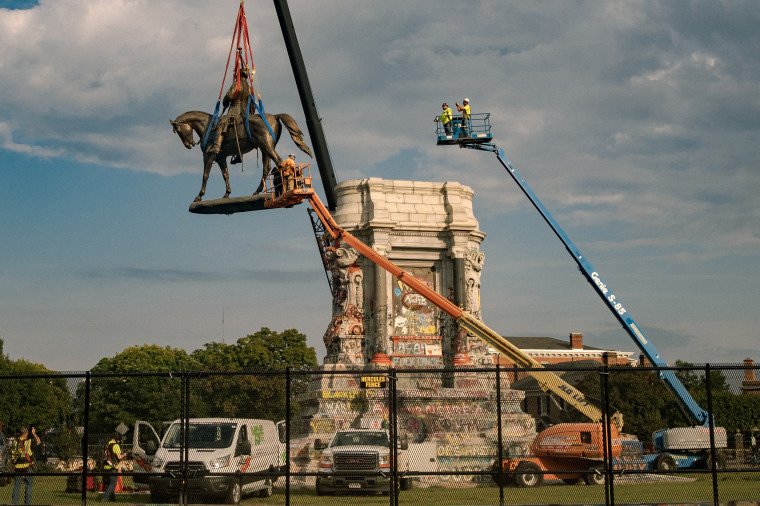How the mighty have fallen.
Or in this case, how far the enormous statue of Robert E. Lee has fallen from its high perch over Monument Avenue in Richmond, Virginia. On Wednesday, the Confederate general’s statue took one final, ignoble ride out of the state capital. Despite former President Donald Trump's ridiculous protests to the contrary, Lee’s reputation today seems to mirror his statue: cut to pieces.
On Wednesday, the Confederate general’s statue took one final, ignoble ride out of the state capital.
In 1861, when Lee chose to resign from the U.S. Army, abrogating his officer’s oath and accepting a commission in the Virginia militia, many condemned his action. In fact, when Lee gathered his Unionist family to tell them of his decision, he reportedly acknowledged they would disagree with him.
Other Virginians also questioned his decision. There were eight colonels in the U.S. Army from Virginia at the time the state seceded. All West Pointers, seven remained loyal. Lee and only Lee chose treason, chose to try to destroy the United States. And in doing so, he chose to fight for a new country dedicated to human enslavement. He certainly understood slavery, having spent more than two years from late 1857 to early 1860 running the plantation at Arlington, with its around 200 enslaved workers.
Lee fought for slavery because he believed in slavery.
That is the context of why his statue in Richmond needed to come down, as have similar statues across the country. Gen. Ulysses S. Grant destroyed Lee’s army. Yet, Lee remained the most revered figure among white Southerners for the next hundred years. Statues went up to his memory all over the South, including the 1890 gargantuan statue in Richmond. The state of Virginia led the nation in making Lee an American hero.
Want more articles like this? Follow THINK on Instagram to get updates on the week's most important political analysis
But the reverence for Lee served a terrible purpose: to further a white supremacist society. It’s time for Virginia — and the rest of America — to move on.
To be clear, Lee has always had critics. Frederick Douglass recoiled at the “nauseating flatteries” about Lee. Douglass abhorred statues to him, calling them “monuments of folly.”
In 1928, W.E.B. DuBois criticized Lee because he “led a bloody war to perpetuate slavery.” As historian Hilary Green has shown, the Black citizens of Richmond protested mightily against monuments to Lee and the Confederates.
Yet, groups like the United Daughters of the Confederacy worked overtime to ensure all white Americans saw Lee through the lens of the “Lost Cause” mythology. That myth required a sainted figure, and groups like the UDC chose the most successful soldier in gray
The UDC controlled textbooks to ensure Lee was presented in a god-like fashion and the true cause of the Civil War, slavery, was obscured. Among white Americans, the UDC’s view of the war came close to winning, especially after the last Civil War veterans died.
During this time, the white South gained political dominance by rewriting its constitutions to exclude Blacks from political power. Flattering biographies of Lee furthered the lie that the Confederates really didn’t fight over slavery. Incredibly, Lee became a symbol of strength and patriotism for most white Americans during World War I and War II.
Incredibly, Lee became a symbol of strength and patriotism for most white Americans during World War I and War II.
President Franklin Roosevelt dedicated the Lee monument in Dallas, calling Lee a true American gentleman. President Dwight Eisenhower kept a painting of Lee in the Oval Office. Lee’s transformation from traitor to American hero seemed complete.
During the civil rights era, Virginia commissioned fourth, seventh and 11th grade textbooks that made Lee the most important part of the Civil War history. By concentrating on Lee, Virginia could avoid talking about slavery during a time it fought segregation through “massive resistance” to federal court rulings.
By the 1970s, criticism was taking root, as a few historians as well as many Black activists started to gain ground against the Lee mythology. Still, movies like “Gettysburg” in 1993 still made Lee look like a gentleman warrior.
But finally, the facts started to catch up. Historians wrote about how his army captured free Black people in Pennsylvania during the Gettysburg campaign and shipped them South for enslavement. One Pennsylvanian called it “a regular slave-hunt.” Lee’s army slaughtered Black prisoners of war after the Battle of the Crater in 1864.
After the war, Lee testified before Congress that if he had the choice, he would force all Black people to leave Virginia, a call for ethnic cleansing. Lee called Black people fit only to serve as a laboring class with no political rights. Lee’s own words damned him.
In 2015, the view of the Confederacy changed for most Americans, finally. When a white supremacist murdered churchgoers in Charleston, South Carolina, a picture surfaced of him holding a Confederate flag. Clearly, Dylann Roof understood what the United Daughters of the Confederacy had worked so hard to obscure.
Then, white nationalists flying the Confederate flag and the Nazi flag marched to save the Lee statue in Charlottesville, Virginia. Those racists also understood what many other Americans seemed to avoid. The Confederacy, and its leader Robert E. Lee, fought to maintain a society built on racial slavery.
Predictably, Trump's statement supporting Lee trots out all of the top myths and half-truths: that he was a brilliant general and true American patriot who only wanted what was best for Virginia. Such words ring quite hollow. Indeed, in many ways, the mainstream view of Lee today has come full circle. Black Americans and loyal military officers believed Lee chose treason to preserve slavery during the Civil War.
We should commemorate people who represent our national values. As the Lee statue rides off in pieces, Richmond, at least, represents the America we should hope to become.
Related:


